Obscurins: Goliaths and Davids take over non-muscle tissues
- PMID: 24516603
- PMCID: PMC3916441
- DOI: 10.1371/journal.pone.0088162
Obscurins: Goliaths and Davids take over non-muscle tissues
Erratum in
-
Correction: Obscurins: Goliaths and Davids Take over Non-Muscle Tissues.PLoS One. 2018 Jan 3;13(1):e0190842. doi: 10.1371/journal.pone.0190842. eCollection 2018. PLoS One. 2018. PMID: 29298356 Free PMC article.
Abstract
Obscurins comprise a family of proteins originally identified in striated muscles, where they play essential roles in myofibrillogenesis, cytoskeletal organization, and Ca(2+) homeostasis. They are encoded by the single OBSCN gene, and are composed of tandem adhesion domains and signaling motifs. To date, two giant obscurin isoforms have been described in detail that differ only at the extreme COOH-terminus; while obscurin-A (∼720 kDa) contains a non-modular COOH-terminus that harbors binding sites for the adaptor proteins ankyrins, obscurin-B (∼870 kDa) contains two COOH-terminal serine-threonine kinase domains preceded by adhesion motifs. Besides the two known giant obscurins, a thorough search of transcript databases suggests that complex alternative splicing of the obscurin transcript results in the generation of additional giant as well as small isoforms with molecular masses ranging between ∼50-970 kDa. These novel isoforms share common domains with the characterized isoforms, but also contain unique regions. Using a panel of highly specific antibodies directed against epitopes spanning the entire length of giant obscurins, we employed western blotting and immunohistochemistry to perform a systematic and comprehensive characterization of the expression profile of obscurins in muscle and non-muscle tissues. Our studies demonstrate for the first time that obscurins are not restricted to striated muscles, but are abundantly expressed in several tissues and organs including brain, skin, kidney, liver, spleen, and lung. While some obscurin isoforms are ubiquitously expressed, others are preferentially present in specific tissues and organs. Moreover, obscurins are present in select structures and cell types where they assume nuclear, cytosolic, and membrane distributions. Given the ubiquitous expression of some obscurins, along with the preferential expression of others, it becomes apparent that obscurins may play common and unique roles, respectively, in the regulation and maintenance of cell homeostasis in various tissues and organs throughout the body.
Conflict of interest statement
Figures


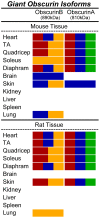

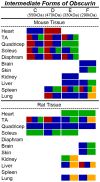




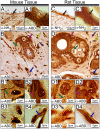

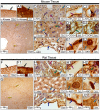

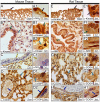
References
-
- Russell M (2002) Identification, tissue expression and chromosomal localization of human Obscurin-MLCK, a member of the titin and Dbl families of myosin light chain kinases. Gene 282: 237–246. - PubMed
-
- Kontrogianni-Konstantopoulos A, Bloch RJ (2005) Obscurin: a multitasking muscle giant. J Muscle Res Cell Motil 26: 419–426. - PubMed
-
- Fukuzawa A, Idowu S, Gautel M (2005) Complete human gene structure of obscurin: implications for isoform generation by differential splicing. J Muscle Res Cell Motil 26: 427–434. - PubMed
Publication types
MeSH terms
Substances
Grants and funding
LinkOut - more resources
Full Text Sources
Other Literature Sources
Miscellaneous

